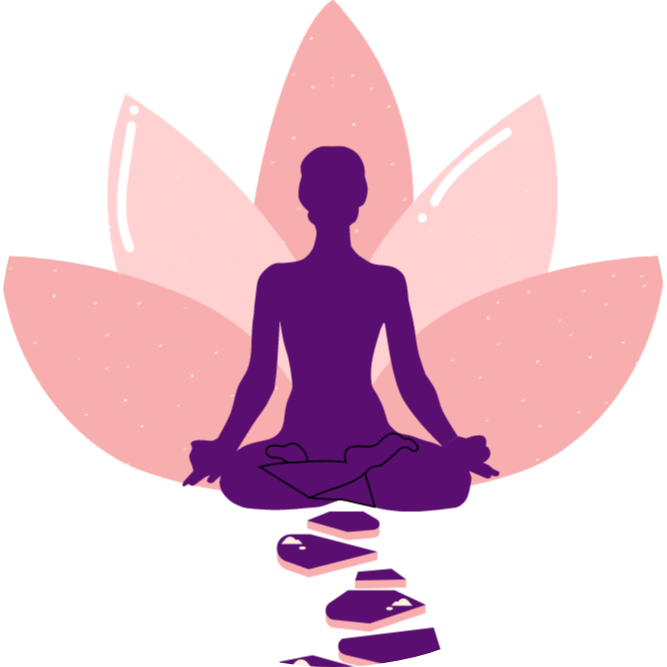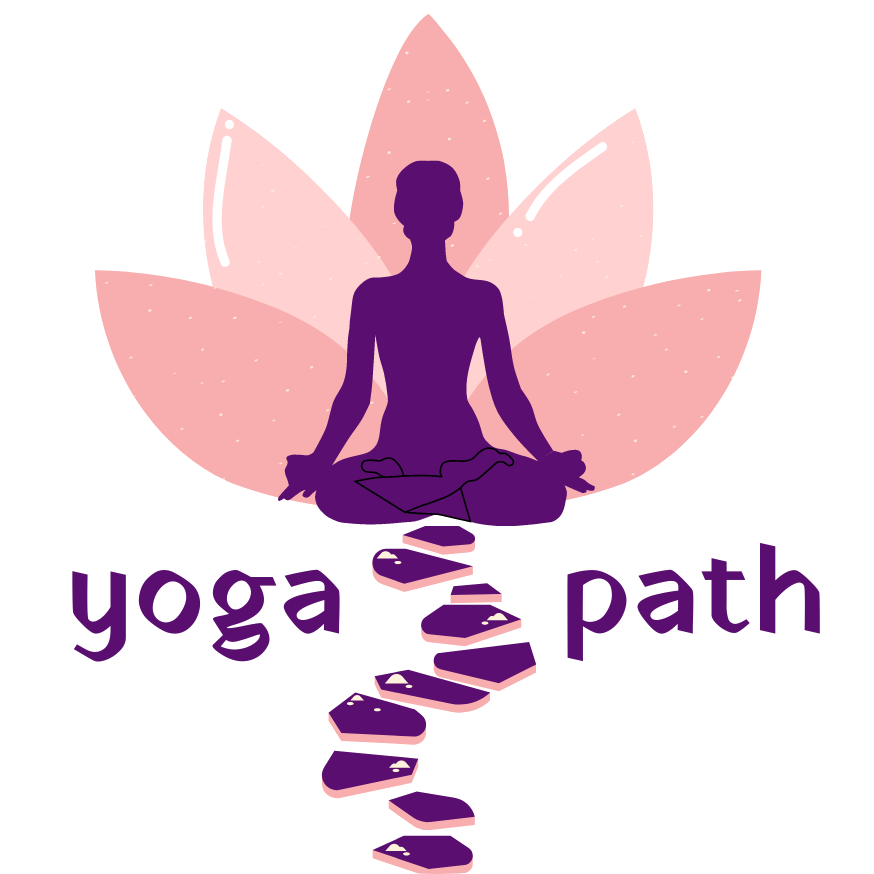Practise Yoga Asanas
Learn Asanas - Inversion Poses
Inversion Asanas are yoga poses that place your head below your heart and hips, thus ‘inverting’ your body from its normal upright position. These inverted asanas reverse the action of gravity on the body. They encourage the blood flow to the brain, nourishing the neurons and flushing out toxins. The benefits of inversion asanas include increased blood and lymphatic circulation, as well as improved flexibility, strength, energy levels, and self-confidence.
Inversion asanas include Adho Mukha Svanasana (Downward facing dog), Child’s Pose (Balasana), Forward Fold Pose (Uttanasana), Crow Pose (Bakasana), Headstand (Salamba Shirshasana), Feathered Peacock (Pincha Mayurasana), Handstand (Adho Mukha Vrksasana), and Wheel Pose (Chakrasana).
Remember, to start with simple, low intensity moves when starting as a beginner to reduce your risk of injury. If you’re new to yoga, please work with a certified Yoga instructor to ensure you’re performing the moves safely and correctly.
Adho Mukho Svanasana / Downward Facing Dog
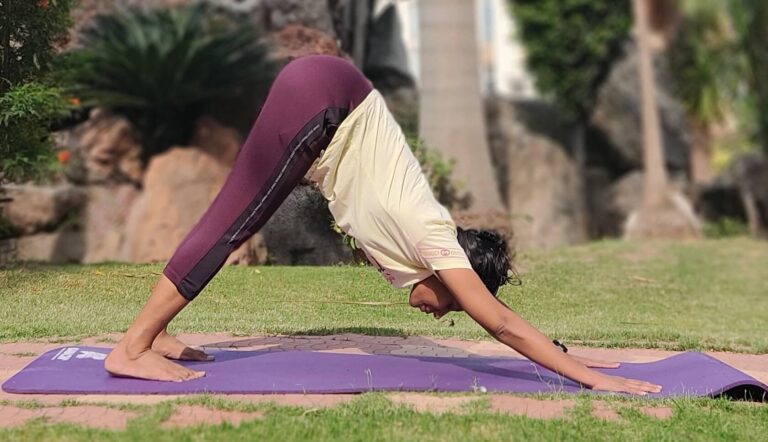
Inversion Asana
Adho meaning down, mukho meaning Face, svana meaning Dog. This asana too is part of the flow of surya namasakar (salute to the sun).
The name is derived from the way the dog stretches his front limbs when getting up.
In this pose, we can start by sitting on all fours in a table top position with knees and palms on the floor. The palms are at shoulder distance on the floor also the knees and feet are at hip distance apart. Lift the knees up to raise the hips up as you inhale. The weight of the body is on both palms and feet. With both arms straight at the elbows and the legs being straight at the knees the hips are raised up the head is down with arms close to the ears. We try to press the chest into the thighs just as we try to close a book to make a V shape. As you exhale, lower down the knees, hips and back into table top.
Contraindications:
Pregnant women, high blood pressure, Weak eye capillaries,
detached retina, or any other infection or inflammation of the eyes and ears and shoulder or back injury
Benefits:
Stretches the hamstring and calf muscles
Strengthens arms and shoulders, legs and ankles
Relaxes and strengthens back muscle
Strengthens abdominal muscles and core
Improves posture
And calms the heart
Ardha Adho Mukho Vrksasna
Half Handstand Pose / L-stand Pose with chair
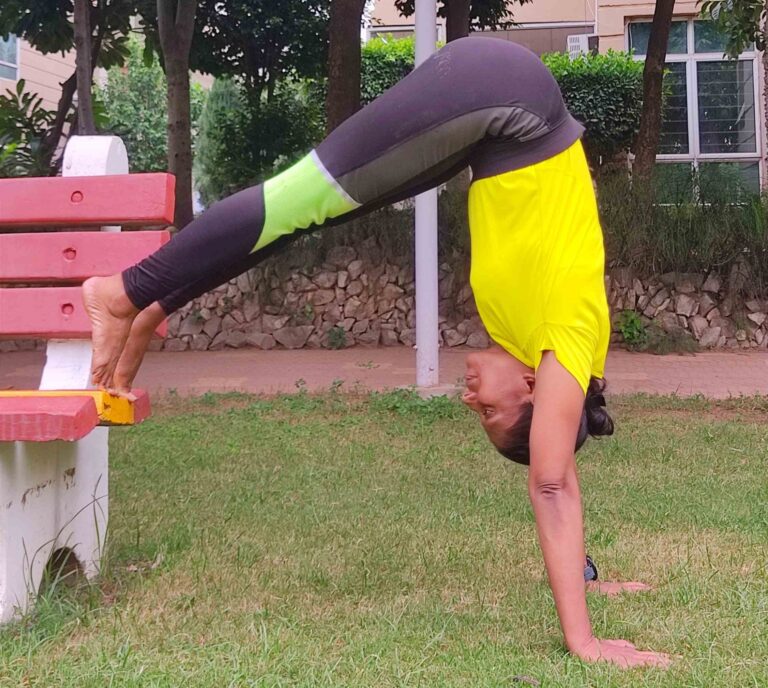
Inversion Position
Ardha Adho Mukho Vrksasna – Half Handstand Pose / L-stand Pose with chair.
This is an inversion pose, it is an intermediate level yoga pose
For this asana, push a chair up against the wall with the seat facing away from the wall.
Stand facing away from the chair in front of the chair. Bend forward and downward, firmly press your palms onto the floor and place your feet on the chair seat.
Press your toes down into the chair as you elevate your hips.
Slowly walk your hands back so that they align under your shoulders.
Stack your hips above your shoulders. Make sure elbows are straight. Lengthen your neck and open your chest. Finally you are aligned in “L” Handstand but with the feet lower than the hips.
Contraindications:
Do not try this pose if you have a shoulder or wrist injury, have high blood pressure, if you are menstruating, pregnant or if you have a headache. glaucoma or detached retina.
Benefits:
Strengthens wrists, arms and shoulders building upper body strength.
Strengthens core.
Lengthens and stretches the spine
Improves body stability and balance.
Prepares you for other inversion poses.
Stimulates the Circulatory, Respiratory, Skeletal and Muscular Systems.
Energizes the entire body, builds self-confidence, Brings joy and drives away lethargy.
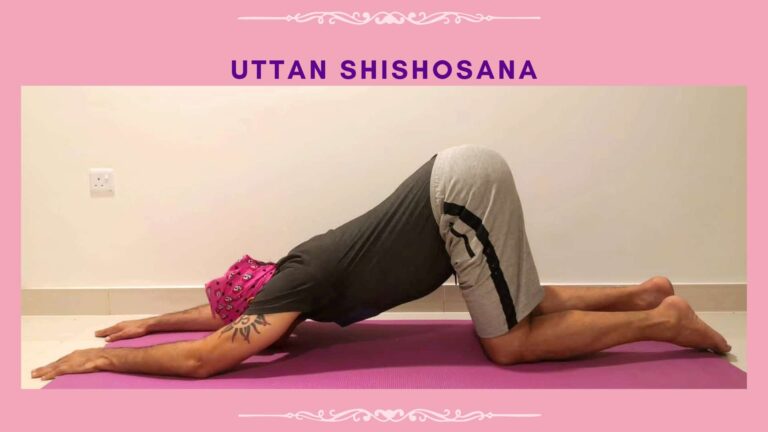
Inversion Asana
It is a combination of two different asanas, the Child Pose and the Downward Facing Dog Pose and is also known as the Extended Puppy Pose.
This pose relieves stress by deeply stretching the spine. It increases self-confidence and a feeling of self-love. This asana releases any tension knotted up in your back and shoulders, if you have a desk job or you are feeling fatigued.
Start from a tabletop position, i.e. on all four limbs with knees stacked under hips and your and palms right under shoulders.
Press your feet firmly on the mat and keep your toes flat out with sole facing ceiling.
While exhaling, keep your hands in front of you. Now allow your chest to slowly lower down towards the floor while slowly placing your forehead on the mat.
Spread your palms firmly on the floor. Stretch your arms ahead of you on the floor so that your shoulders get broadened. The hips remain upwards and behind.
Hold the stretch for around 5-7 breaths while breathing deeply. Release by coming back into the tabletop position and then sitting in Vajrasana.
Contraindications:
Knee injury, Back injury, Hip injury, and Frozen shoulder
Benefits:
Stretches spine and shoulders
Strengthens the body including hip, upper back and arms
Makes spine flexible and strong
Releases stress and tension
Induces deep sleep and cures insomnia
Calms the mind with its regular practice.
Improves posture
Activates the Heart / Anahata Chakra and Throat / Vishudha Chakra
Increases self confidence
Make you cheerful and optimistic
Improves breathing capacity of lungs
Hastapadasana
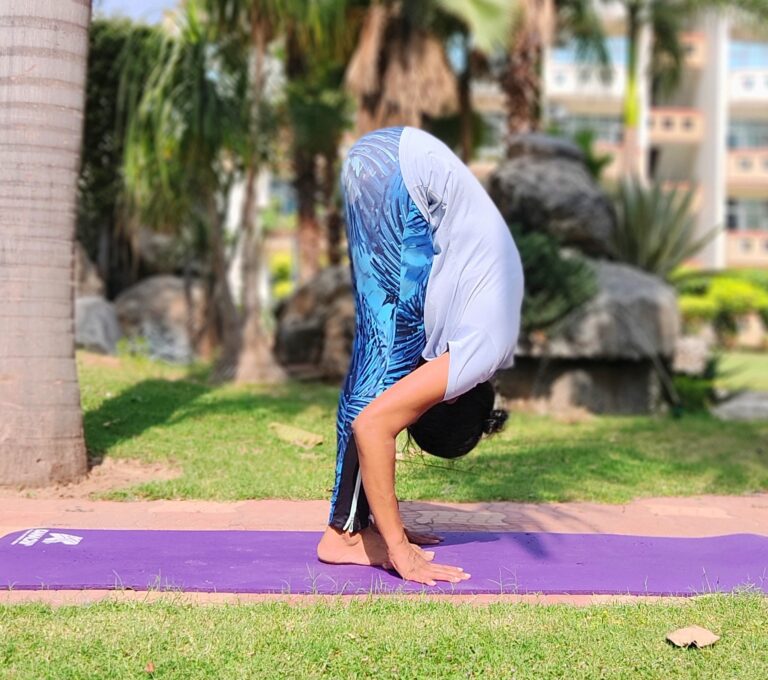
Standing Inverted Position – Forward Bend
Hastapadasana meaning Hand to Feet Pose
This asana flows with humility and acceptance of the self along with surrender to the universe. It represents a cycle of energy generated within the body and offered to the universe.
Stand with your feet together and hands at the side.
While inhaling, raise both your hands from the front above your head.
While exhaling, bring the your hands down to touch your toes or grasp your ankles keeping your knees straight.
Remember to keep your ears and hands together as a unit as you bend down or rise up. Keeping your knees straight, try to touch your forehead to the knees. Stay in the position for 6 seconds breathing normally – extend to 2 minutes.
While inhaling, raise your hands up above your head and exhaling bring your arms down to the sides.
Contraindications:
Hypertension, Cardiac ailments, Pregnancy, Peptic ulcers, Hernia, Back or Spinal Injuries, Cervical spondylitis, Slipped disc and serious Eye disorders such as glaucoma and myopia.
Benefits:
Results in extreme stretching of back and leg muscles
Brings flexibility to your spine
Abdominal compression provides good circulation and massage to abdomen and pelvic organs
Tones the abdominal wall and reduces unnecessary fat deposits in the abdominal area
Induces clavicular breathing and aids proper ventilation of the uppermost part of the lungs
Stimulates the nervous system and endocrine system
Improves blood circulation
Aids sleep
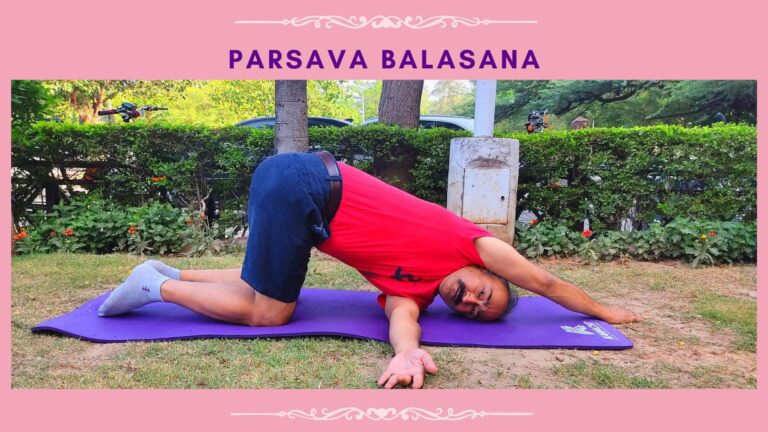
Seated Inversion Asana – Forward Bend
In Sanskrit parsva, means “revolved,” bala, means “child,” and asana, means “pose”. Parsava Balasana is thus also called the revolved child pose
Start with the tabletop position on the yoga mat.
With palms placed on the floor shoulder width apart and stacked just under the shoulders, while the knees are stacked under the hips. Now tuck your toes under the feet.
Slowly slide the right arm to the left side of the yoga mat under the left shoulder. Turn the chest to the left side, so that the left shoulder lifts up and the right shoulder rests on the ground and rest the right side of your head on the mat, gazing to your right hand.
Lift the left arm, straighten it out above the head and place the palm on the floor with the upper arm close to the left ear. Release the tension in your shoulder by breathing naturally.
Hold in this position for few seconds (30 to 90 seconds). Exit the pose by sliding the right arm back to the table top pose.
Repeat all the above steps with the opposite side.
Practicing this pose at least 2 times by both sides will give better results.
Contraindications:
Back injury, Neck injury, Hip problems and Shoulder problems
Benefits:
Reduces stress and tension, calms the mind
Perfect for anyone experiencing chronic stress and tension, especially in the upper body, neck and shoulder. This twist through the spine helps to “wring out” negative energy, releasing both physical and mental tension, and invites fresh blood for nourishment to these areas.
Stimulates the abdominal organs and thus, improves the digestion system.
Helps balance the Root / Muladhara Chakra, which helps one feel more grounded and connected to the earth. Additionally, this chakra supports living in security, stillness and clarity, and giving relief from daily stress.
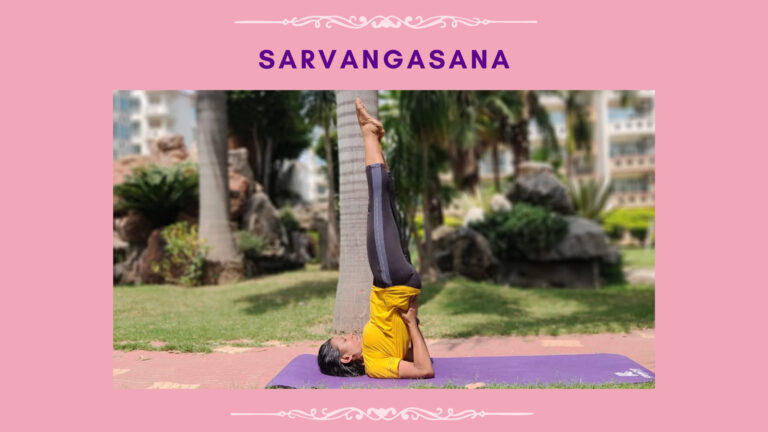
Inversion Pose
‘Sarva Anga’ – means full body. It is beneficial for all the systems of the body, especially the head that houses the brain.
Lie supine on a mat with your feet together and hands at the sides. While exhaling, raise your legs up together, toes to point towards the ceiling. Keep knees straight. Use your hands to support your body at the back the chin is set against the chest.
Maintain this pose for a few seconds or as long as convenient but not longer than two minutes, the breathing slow, rhythmic and natural.
Slowly bend your knees, then, as you inhale, lower your hips towards the mat, releasing your hands from back, lower the legs slowly without jerking the head.
Take a few deep breaths.
Precautions To Be Taken during Performance of This Asana:
Avoid any possible extreme strain. It is best to attempt this asana first in stages and attempt this asana only after a few weeks of preparation.
What needs emphasis is the fact that this pose should never be attempted after any form of rigorous Exercises because the rush of blood to the brain at this stage might do more harm than good. Place importance on the position and comfort of the neck.
Contraindications:
Hypertension, cardiac ailments, Pregnancy, Respiratory disorders, Cervical spondylosis, spinal problems, neck injuries or trauma, High myopia, glaucoma, serious eye disorders.
Benefits:
Physical
It strengthens your arms and shoulders.
It keeps your spine flexible.
It nourishes your brain with more blood.
It improves the functioning of your thyroid, parathyroid, and pituitary glands.
There are favourable changes in vasomotor ability due to the increased interchange of blood in the upper part of the body, especially the thorax, the neck, and the head.
Relief from congestion, through the rapid drainage of venous blood, in the abdominal and pelvic regions.
There is a good healing effect of gravity on the various organs of your body above the waist, including the endocrine glands.
It helps alleviate varicose veins.
It is helpful in constipation, dyspepsia, headache, giddiness, neurasthenia, functional disorders of the eye, the ear, the nose and the throat, general and sexual debility. It helps alleviate piles and fissures.
This is one of the most effective asanas for the increase of blood flow towards your brain., it not only impacts the whole body it makes your mind alert giving a feeling of self-confidence and self-reliance.
Psychological
It relieves stress as it calms your brain and nervous system.
It helps to balance the moods and calms your mind.
It increases your confidence.
Muscles Involved:
Trunk flexors and wrist extensors.
Flexors and extensors of the lower limbs.
Extensors of the neck and erector spinae.
Isometric contraction of the hip and knee.
